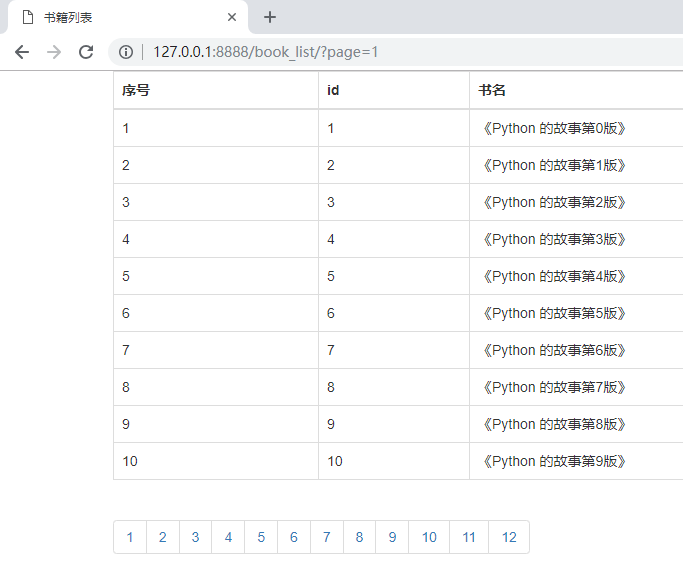Python Django 简单分页的实现代码解析
这篇文章主要介绍了Python Django 简单分页的实现代码解析,文中通过示例代码介绍的非常详细,对大家的学习或者工作具有一定的参考学习价值,需要的朋友可以参考下
models.py:
from django.db import models
class Book(models.Model):
title = models.CharField(max_length=32)
def __str__(self):
return self.title
class Meta:
db_table = "books"
批量创建 106 条数据
import os
if __name__ == '__main__':
os.environ.setdefault("DJANGO_SETTINGS_MODULE", "mysite3.settings")
import django
django.setup()
from app01 import models
# 106 个书籍对象
objs = [models.Book(title="《Python 的故事第{}版》".format(i)) for i in range(116)]
# 在数据库中批量创建, 10 次一提交
models.Book.objects.bulk_create(objs, 10)
views.py:
from django.shortcuts import render
from app01 import models
def book_list(request):
# 从 URL 中取参数
page_num = request.GET.get("page")
print(page_num, type(page_num))
page_num = int(page_num)
# 定义两个变量保存数据从哪儿取到哪儿
data_start = (page_num-1)*10
data_end = page_num*10
# 书籍总数
total_count = models.Book.objects.all().count()
# 每一页显示多少条数据
per_page = 10
# 总共需要多少页码来显示
total_page, m = divmod(total_count, per_page)
if m:
total_page += 1
all_book = models.Book.objects.all()[data_start:data_end]
# 拼接 html 的分页代码
html_list = []
for i in range(1, total_page+1):
tmp = '<li><a href="/book_list/?page={0}" rel="external nofollow" >{0}</a></li>'.format(i)
html_list.append(tmp)
page_html = "".join(html_list)
return render(request, "book_list.html", {"books": all_book, "page_html": page_html})
book_list.html:
<!DOCTYPE html>
<html lang="en">
<head>
<meta charset="UTF-8">
<title>书籍列表</title>
<link rel="stylesheet" href="/static/bootstrap/css/bootstrap.min.css" rel="external nofollow" >
</head>
<body>
<div class="container">
<table class="table table-bordered">
<thead>
<tr>
<th>序号</th>
<th>id</th>
<th>书名</th>
</tr>
</thead>
<tbody>
{% for book in books %}
<tr>
<td>{{ forloop.counter }}</td>
<td>{{ book.id }}</td>
<td>{{ book.title }}</td>
</tr>
{% endfor %}
</tbody>
</table>
<nav aria-label="Page navigation">
<ul class="pagination">
{{ page_html|safe }}
</ul>
</nav>
</div>
</body>
</html>
运行结果:

以上就是本文的全部内容,希望对大家的学习有所帮助,也希望大家多多支持【听图阁-专注于Python设计】。

